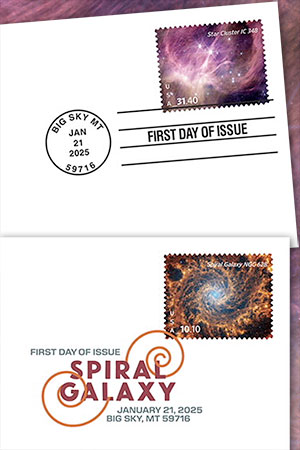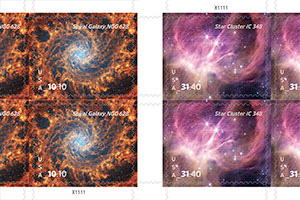January 21, 2025 — The vast, unobstructed skies that gave Big Sky, Montana its name made for an appropriate setting today (Jan. 21) for the release of two new United States postage stamps depicting the seemingly infinite vistas visible to the James Webb Space Telescope (JWST).
As the location of the "First Day of Issue" for the U.S. Postal Service's (USPS) 2025 Priority Mail and Priority Mail Express stamps, Big Sky ceremonially began the nationwide sales of the colorful postage featuring images of a sprawling galaxy and a wispy nebula. The release was accompanied by the availability of related collectibles, including First Day of Issue "covers" — what collectors call stamped and postmarked envelopes.
"NASA's James Webb Space Telescope is the largest and most sensitive infrared telescope ever deployed in space. Revealing the cosmos in vivid infrared detail, it is designed to provide scientists with breathtaking images and new data. It is already providing new insights into our cosmic origins and revealing new questions about the universe to explore," reads USPS' description of the stamps.
The $10.10 Priority Mail "Spiral Galaxy" stamp shows NGC 628, a "celestial nautilus" located 32 million light years from Earth. Captured by the Webb in 2022, "this and other images of spiral galaxies help scientists investigate the star formation cycle in galaxies on an unprecedented new scale and provide valuable new clues to the origins of our universe," according to the postal service.
Sold in panes of four stamps, "Spiral Galaxy" is based on a Webb photo provided by NASA, ESA (European Space Agency), the Canadian Space Agency, Janice Lee of the STScI (Space Telescope Science Institute), Thomas Williams of Oxford and the PHANGS (Physics at High Angular resolution in Nearby GalaxieS) team.
"I assisted with the planning and execution of the image taken," said Danny Dale, a professor of physics and astronomy and associate dean of the University of Wyoming College of Engineering and Physical Sciences, in a statement. "We used NASA's James Webb Space Telescope (JWST) to take this multicolor image at infrared wavelengths."
"I hope young people find it inspiring and that it motivates them to pursue a STEM (science, technology, engineering and mathematics) career if that's what excites them," he said.
The $31.40 Priority Mail Express "Star Cluster" stamp is also for sale in panes of four. Star Cluster IC 348 has provided clues to the origins of stars and planetary systems. Between the billowing pink, purple and white curtains reproduced on the stamp are brown dwarfs, objects that are too small to be stars but are larger than most planets.
"Using JWST's NIRSpec (Near-Infrared Spectrometer) instrument, the 'spectral signature' of a mystery molecule containing both hydrogen and carbon atoms was identified in two of the brown dwarfs. It is the first time scientists have detected the particular infrared signature of this molecule in an atmosphere outside of our own solar system," reads the USPS description.
As with the "Spiral Galaxy" stamp, USPS art director Greg Breeding designed the "Star Cluster" stamp using an image provided by NASA, ESA, the Canadian Space Agency and STScI, as well as Kevin Luhman of Penn State University and Catarina Alves de Oliveira with ESA.
To commemorate the release, the postal service has prepared first day covers affixed with either the Priority Mail or Priority Mail Express stamps and postmarked in Big Sky, Montana with Tuesday's date. There are two different cancellation devices, as well: a standard circular date ink stamp with four "killer bars" and a digital color postmark in either orange an maroon for "Spiral Galaxy" or purple and lavender for "Star Cluster."
The first day of issue (black ink) covers cost $10.65 for Priority Mail and $31.95 for Priority Mail Express. The digital color covers are $11.50 and $32.80, respectively.
First day postmarks are also available for no more than a cost of a stamp (or two). The public has until May 21 to buy and affix the "Spiral Galaxy" or "Star Cluster" stamps (or both together) to an envelope or envelopes, self-address or address it to others and then mail it (them) inside a larger envelope to:
FDOI — Spiral Galaxy or Star Cluster
USPS Stamp Fulfillment Services
8300 NE Underground Drive, Suite 300
Kansas City, MO 64144-9900
After applying the first day of issue postmark, the USPS will return the envelope through the mail. There is no charge for the postmark up to a quantity of 50, after which it is 5 cents per additional postmark.
Collectors and the public can also send stamped envelopes and postcards without addresses for postmark, so long as they supply a larger self-addressed envelope with adequate postage. After applying the postmark, the post office will return the covers (with or without addresses) in the addressed larger envelope.
The 2024 Priority Mail and Priority Express Mail stamps featured different Webb images, including an infrared version of the "Pillars of Creation" and "Cosmic Cliffs," one of the JWST's first targets. The Webb Space Telescope was also the subject of a 2022 Forever denomination stamp that featured an artist's rendering of the deployed observatory in deep space. |
|

The U.S. Postal Service on Tuesday, Jan. 21, 2025, issued two Priority Mail stamps featuring images taken by the James Webb Space Telescope. (USPS/collectSPACE)

The postmarks include the date (Jan. 21, 2025) and location (Big Sky, Montana) of the first day of issue. (USPS/collectSPACE)

Both the Priority Mail "Spiral Galaxy" and Priority Mail Express "Star Cluster" stamps are sold in panes of four. (USPS/collectSPACE) |
